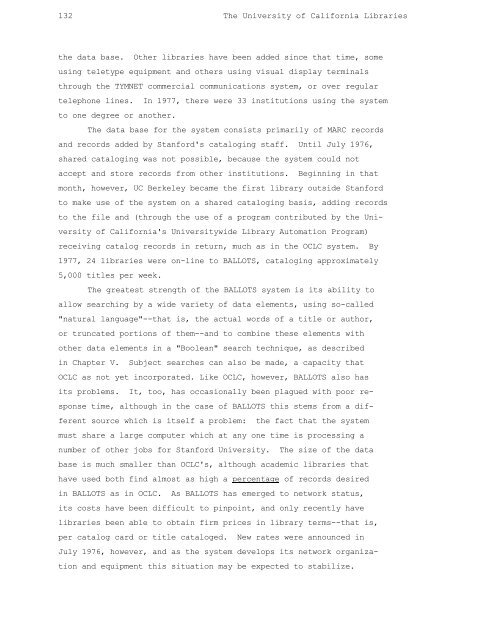The University of California Libraries: A Plan for Development (1977)
The University of California Libraries: A Plan for Development (1977)
The University of California Libraries: A Plan for Development (1977)
You also want an ePaper? Increase the reach of your titles
YUMPU automatically turns print PDFs into web optimized ePapers that Google loves.
132 <strong>The</strong> <strong>University</strong> <strong>of</strong> <strong>Cali<strong>for</strong>nia</strong> <strong>Libraries</strong><br />
the data base. Other libraries have been added since that time, some<br />
using teletype equipment and others using visual display terminals<br />
through the TYMNET commercial communications system, or over regular<br />
telephone lines. In <strong>1977</strong>, there were 33 institutions using the system<br />
to one degree or another.<br />
<strong>The</strong> data base <strong>for</strong> the system consists primarily <strong>of</strong> MARC records<br />
and records added by Stan<strong>for</strong>d's cataloging staff. Until July 1976,<br />
shared cataloging was not possible, because the system could not<br />
accept and store records from other institutions. Beginning in that<br />
month, however, UC Berkeley became the first library outside Stan<strong>for</strong>d<br />
to make use <strong>of</strong> the system on a shared cataloging basis, adding records<br />
to the file and (through the use <strong>of</strong> a program contributed by the <strong>University</strong><br />
<strong>of</strong> <strong>Cali<strong>for</strong>nia</strong>'s <strong>University</strong>wide Library Automation Program)<br />
receiving catalog records in return, much as in the OCLC system. By<br />
<strong>1977</strong>, 24 libraries were on-line to BALLOTS, cataloging approximately<br />
5,000 titles per week.<br />
<strong>The</strong> greatest strength <strong>of</strong> the BALLOTS system is its ability to<br />
allow searching by a wide variety <strong>of</strong> data elements, using so-called<br />
"natural language"--that is, the actual words <strong>of</strong> a title or author,<br />
or truncated portions <strong>of</strong> them--and to combine these elements with<br />
other data elements in a "Boolean" search technique, as described<br />
in Chapter V. Subject searches can also be made, a capacity that<br />
OCLC as not yet incorporated. Like OCLC, however, BALLOTS also has<br />
its problems. It, too, has occasionally been plagued with poor response<br />
time, although in the case <strong>of</strong> BALLOTS this stems from a different<br />
source which is itself a problem: the fact that the system<br />
must share a large computer which at any one time is processing a<br />
number <strong>of</strong> other jobs <strong>for</strong> Stan<strong>for</strong>d <strong>University</strong>. <strong>The</strong> size <strong>of</strong> the data<br />
base is much smaller than OCLC's, although academic libraries that<br />
have used both find almost as high a percentage <strong>of</strong> records desired<br />
in BALLOTS as in OCLC. As BALLOTS has emerged to network status,<br />
its costs have been difficult to pinpoint, and only recently have<br />
libraries been able to obtain firm prices in library terms--that is,<br />
per catalog card or title cataloged. New rates were announced in<br />
July 1976, however, and as the system develops its network organization<br />
and equipment this situation may be expected to stabilize.
















